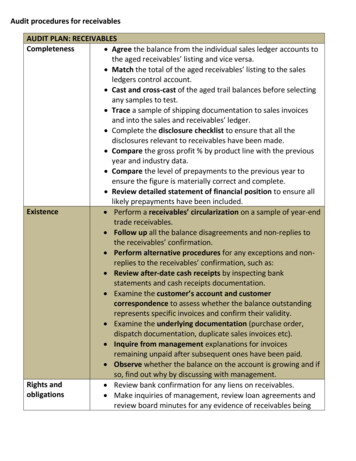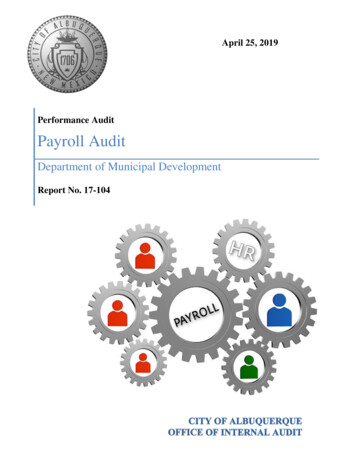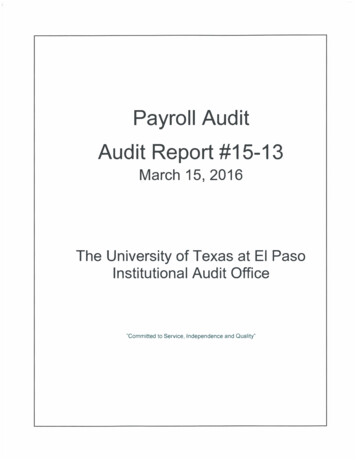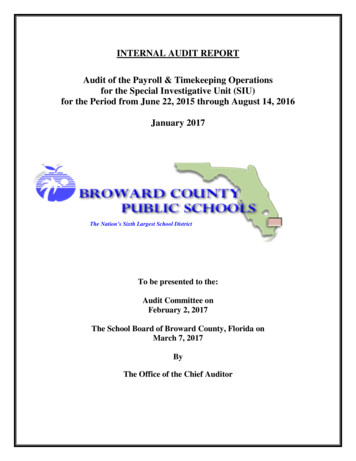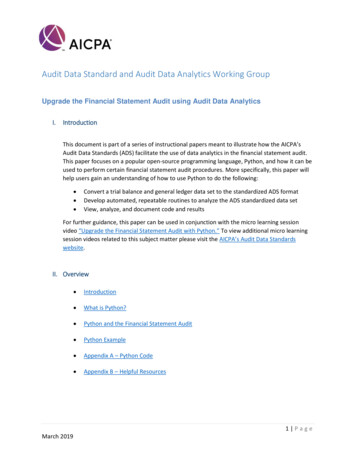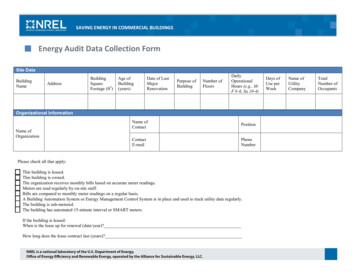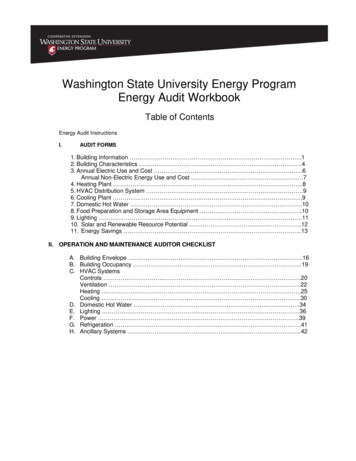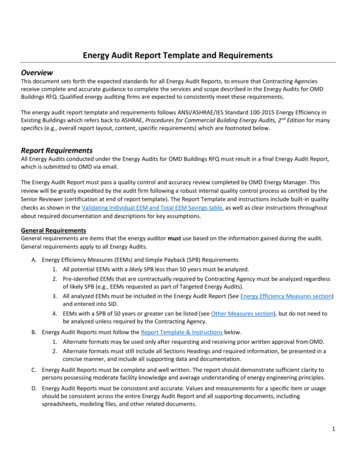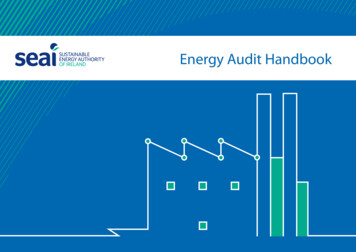
Transcription
Energy Audit Handbook1
BOOKMARKContentsIntroduction 41. Undertaking an energy audit51.1What is an energy audit?61.2Why carry out an energy audit?61.3How does an energy audit work?62. Initial preparation 92.1Arrange the introductory meeting2.2Agree the approach 102.3Request specific information and data102.4Identify key personnel113. Pre-analysis and planning3.1Undertake preliminary analysis3.5Develop an audit checklist215.3.3Potential pitfalls 353.5.1Energy Venn diagram sample application225.3.4Other resources 353.5.2Sample audit checklist for compressed air system235.4Heating, ventilation and air conditioning (HVAC)365.4.1What to check365.4.2Typical opportunities 364. Conducting the site visit255.4.3Potential pitfalls 364.1Devise site visit agenda265.4.4Other resources 364.2Consider health and safety265.5Pumps 374.3Carry out site visit265.5.1What to check 374.3.1Assess energy management275.5.2Typical opportunities 375.5.3Potential pitfalls 375.5.4Other resources 375.6Transport 38105. Technical assessment 295.1Buildings 315.6.1What to check5.1.1What to check315.6.2Typical opportunities 385.1.2Typical opportunities 315.6.3Potential pitfalls 385.1.3Potential pitfalls 315.6.4Other resources 38135.1.4Other resources 315.7Refrigeration and cooling39Lighting 325.7.1What to check3912383.2Review best available technologies/practices135.23.3Consider measurement planning and135.2.1What to check325.7.2Typical opportunities 395.2.2Typical opportunities 325.7.3Potential pitfalls 40155.2.3Potential pitfalls 335.7.4Other resources 40Other resources 335.8Industrial processes 413.4portable measuring instrumentsAnalyse current and past performance3.4.1Energy billing data analysis155.2.43.4.2Use of regression analysis185.3Heating and boilers345.8.1What to check3.4.3Use benchmarking 205.3.1What to check345.8.2Typical opportunities 415.3.2Typical opportunities 345.8.3Potential pitfalls 41SEAI: Energy Audit Handbook412
7. Identifying and prioritising50opportunities5.8.4Other resources 415.9Wastewater treatment plants425.9.1What to check425.9.2Typical opportunities 427.1Identify opportunities for improvement515.9.3Potential pitfalls 427.2Generate register of opportunities515.9.4Other resources 427.2.1Recommended information515.10Compressed air 437.3Methods to identify opportunities53437.4Prioritise opportunities535.10.2 Typical opportunities 437.5Data retention 535.10.1 What to check5.10.3 Potential pitfalls 435.10.4 Other resources 435.118. Reporting the results54Renewable energy 446. Financial analysis of opportunities456.1Choice of financial analysis tool6.1.1Small investments 466.1.2Larger investments 466.1.3Additional considerations466.2Validated calculations466.2.1General approach 466.2.2Accuracy considerations466.3Financial analysis methods476.3.1Simple payback 476.3.2Net present value 476.3.3Internal rate of return486.3.4Life cycle costing49SEAI: Energy Audit Handbook468.1Audit Report 558.2Management presentation/closing meeting56Appendices 57Appendix 1: Sample data request58Appendix 2: Best practice and technology resources59Appendix 3: Sample bills analysis tool60Appendix 4: Sample site visit agenda61Appendix 5: Sample financial analysis tool62Appendix 6: Sample register of opportunities63Terms and definitions 643
IntroductionAn ongoing process of energy management can help keep organisations at the leading edge in theirindustries, providing sustained competitive advantage. Given the rate of change in energy technology andmarkets, and the impact that it can have on performance, businesses with a strong track record in the arearecognise the value of maintaining a strategic focus on energy.A more sustainable approach to energy through energyefficiency and the use of renewables often representsthe lowest risk and most cost-effective investment forcompanies looking to improve their environmentalperformance.It will also serve as a useful reference guide for thoseundertaking the energy audit, be they internal orexternal auditors.One of the first steps for an organisation in adoptinga more sustainable approach to energy is carrying outan energy audit. Completing an energy audit gives acompany a better picture of its energy consumptionand identifies opportunities for improvement –often delivering immediate cost savings. It can alsodemonstrate compliance with legal obligations whichrequire certain organisations to undertake energy audits.The handbook sets out the complete energy auditprocess guiding users each step of the way – from auditpreparation and pre-analysis through to conductingthe site visit and reporting findings. It gives the user abetter understanding of what to expect from an energyauditor which can be particularly useful for companiespreparing for their first audit. The handbook includessome key resources and a range of references offeringa best practice framework for both high level andtechnically detailed use.The Sustainable Energy Authority of Ireland (SEAI) hasdeveloped this comprehensive Energy Audit Handbookas a step-by-step guide to energy auditing. We believe itwill benefit all organisations considering or carrying outan energy audit; regardless of sector, size or experience.The advice in this handbook is intended to beproportionate, so that the level of detail used by theauditor for any measurement, estimate or analysisprovides a sufficiently accurate picture of energyperformance. This will facilitate relevant andSEAI: Energy Audit Handbookmeaningful decision-making on energy improvementopportunities identified.Important Note: The Energy Audit Handbookdoes not aim to be a definitive energy auditguide, and compliance with this handbook doesnot confirm compliance with the legal auditingobligations set out in the Energy EfficiencyDirective 2012, transposed into Irish law asSI 426 (2014). For more information on theselegal obligations see the SEAI website: EnergyAuditing Scheme.4
1. Undertaking an Energy AuditSEAI: Energy Audit Handbook
1.1 What is an energy audit?1. Undertaking an Energy AuditAn energy audit is an inspection, survey and analysis of energy flows for identificationof energy savings opportunities in a building, process or system to reduce the amountof energy input into the system, without negatively affecting the output(s).The scope and the level of detail used in an energyaudit should be proportionate and will depend on theimpact of the energy uses and the purpose for whichthe output information will be used. Opportunitiesidentified in an energy audit can vary; they may be of atechnical nature, or they may also relate to how energyis managed by the organisation and/or how people’sbehaviour can influence energy use. All of these typesof opportunities should be considered for inclusion inan energy audit report. To identify technical opportunities by evaluatingsignificant process energy-using componentsor utilities including boilers, refrigeration plant,ventilation systems, building performance andfleet efficiency. To provide clear financial information regardingenergy savings opportunities in order toprioritise these items for the organisation’sdecision-making process. To gain a greater understanding of a part or allof the organisation’s energy usage patterns.1.2 Why carry out an energy audit? To identify potential for using renewable energysupply technologies.There are many reasons for undertaking an energy To achieve compliance with legal requirementssuch as the Energy Efficiency Directive, IndustrialEmissions Directive or the EnvironmentalProtection Agency’s waste license requirements.Tocomply with corporate social responsibility goals.audit including: To improve energy performance and minimisethe environmental impacts of the organisation’soperations.To identify behavioural change opportunities byevaluating current operations and maintenancepractices.SEAI: Energy Audit Handbook To meet customer and shareholder expectations. To inform a strategic plan aimed at minimising theorganisation’s carbon footprint. To contribute to the process for certification toa formal energy management system, as setout in ISO 50001.1.3 How does an energy audit work?ISO50002 (2015) provides clarity on structures forefficient energy audits and is the acknowledgedbaseline for information on energy audits. However,the information in this handbook aims to provideadditional direction, guidance and assistance on theprocess of delivering an energy audit.The energy audit process has twodistinct phases:Phase 1: Preparation & Pre-analysis, andPhase 2: Site Visit & Reporting.6
Step 1Introductory meetingto agree approachStep 2Confirm scope andcollect preliminary dataStep 3Identify key personneland schedule site visitStep 4Develop energyuse baseline andmeasurement planStep 5Develop auditchecklistPhase 1Preparation & Pre-analysisSEAI: Energy Audit Handbookto Phase 27
Step 6Conduct site auditand record findingsStep 7Undertake analysis ofcurrent energy practicesand usage onsiteStep 8Develop graphicinterpretation ofenergy opportunitiesand threatsStep 9Develop final reportwith contexualisedgraphic informationPhase 2Site Visit & ReportingSEAI: Energy Audit Handbook8
2. Initial PreparationSEAI: Energy Audit Handbook
2.1 Arrange the introductory meeting2. Initial PreparationThe purpose of the introductory meeting is to set the context for the energy audit; confirmits scope; engage all relevant organisation personnel in the audit process and requestspecific energy information from the organisation. This information should enable appraisalof the client organisation’s current energy use and energy management system.2.2 Agree the approachPreparation and planning are key to ensuring that aneffective and proportionate audit is conducted. Oncethe rationale for carrying out an energy audit has beenestablished with the client organisation; the scope,level of analysis and the boundaries of the audit shouldbe agreed.For instance, the scope may be organisation-wide(including multi-site locations); it may form part of alarger legal compliance assessment; or it may bespecific to a significant energy-using piece of equipment,department, process, transport fleet or building. Thismay result in the auditor taking a different approachon different sites or different operating areas. The clientorganisation may wish the auditor to focus on a specificarea or process, e.g. refrigeration energy use. Where thereis a legal requirement to audit energy use, the scopingexercise may include establishing the percentage of theorganisation’s energy use to be covered by the audit.SEAI: Energy Audit HandbookWhen planning the audit agenda, it is important to notethe operational patterns of the area to be audited.The best time to audit a significant energy-using piece ofequipment is during both operational periods and nonoperational periods, so that the audit team can identifybaseload reduction opportunities.2.3 Request specific information and dataThe data requested may include any or allof the following: Electricity bills, other fuel bills, meter registrationsystem operator (MRSO) data, gas point registrationnumber (GPRN) data, or access to online billingdata. The energy billing information should span aminimum of one year but ideally should include theprevious three years.Energy monitoring software and data sets, as wellas copies of building layout drawings, piping andinstrumentation diagram/drawings (P&IDs), siteplans, asset or equipment lists, process diagrams,and activity metrics data such as production outputor occupancy weather data may also be requested. Historic energy performance information frommandatory public sector monitoring and reportingdata (M&R), other performance informationcollected such as LIEN, CSO data or previous energyaudits. Known opportunities for energy efficiencyimprovements may also be beneficial at this stage.However, the information request needs to becognisant of the industry or organisation beingaudited; for example, information routinely availablein a highly-regulated industry may not be availablein another industry.A sample basic data requestcan be found in Appendix 110
2.4 Identify key personnelThe success of the audit clearly depends on the availability of keydocuments, the subsequent review of these documents and the datagathered. However, the availability of knowledgeable and experiencedmembers of the client organisation, who may provide significant detailabout operational routines, recent and planned changes, technicalimprovements, or specific areas of concern is also critical.The auditor should identify all key personnel, gain an understandingof their roles and responsibilities, and establish their availability tocooperate with the audit process. A senior director should also beidentified at this point, to sign off on the audit as part of a managementreview.‘Buy in’ will be required from various departments to ensure thatsufficient time and resources are made available to enable the auditorto analyse the main areas of energy consumption, and to determinedepartments’ operational practices and behaviours. Organisationalcommitment should extend wider than just utilities personnel andshould include members of the operations, maintenance teams and anysub-contractors working on site. Typically, production personnel play akey role in determining how much energy is used and they should beincluded in any discussions.SEAI: Energy Audit Handbook11
3. Pre-analysis & PlanningSEAI: Energy Audit Handbook
3.1 Undertake preliminary analysisPreliminary analysis of relevant data provided by the client organisation can help the auditorto carry out more effective site work, as it can highlight potential areas for further investigation.Such areas might include periods with spikes in energy use or any particularly regulatoryconsiderations. These will help id
3.5 Develop an audit checklist 21 3.5.1 Energy Venn diagram sample application 22 3.5.2 Sample audit checklist for compressed air system 23 4. Conducting the site visit 25 4.1Devise site visit agenda 26 4.2 Consider health and safety 26 4.3 Carry out site visit 26 4.3.1 Assess energy management 27 5. Technical assessment 29 5.1 Buildings 31 5.1.1 What to check 31 5.1.2 Typical opportunities 31 .

